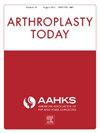Patient “No-Show” Prior to Elective Primary Total Hip Arthroplasty Increases Risk of Postoperative Anemia
IF 1.5
Q3 ORTHOPEDICS
引用次数: 0
Abstract
Background
Patients who “no-show” (NS) clinical appointments are at a higher risk of poor healthcare outcomes. The objective of this study was to evaluate and characterize the relationship between patient NS prior to primary total hip arthroplasty (THA) and 90-day complication risk after THA.
Methods
We retrospectively reviewed 4147 patients undergoing primary THA. Patients were divided based on whether they NS at least 1 appointment vs always attend (AA) appointments. Information collected included number of NS and attended appointments, demographics, comorbidities, and 90-day postoperative complications. Regression analyses were run to identify relationships between NS status and postoperative outcomes, as well as factors that would predict NS status.
Results
Compared to AA patients, NS patients had an increased odds of a postoperative complication (odds ratio:1.3, P = .0005), specifically postoperative anemia (odds ratio: 1.3, P = .0004). When comparing NS and AA patients who both experienced postoperative anemia-related complications, the NS patients had significantly greater intraoperative blood loss compared to AA patients (mean ± standard deviation: 412.6 mL ± 310.2 vs 357.3 mL ± 269.0, P = .028). NS patients also had a greater rate of symptomatic anemia compared to AA patients (100 [3%] vs 25 cases [2%], P = .018). Age, smoking status, gender, race, body mass index, Charlson Comorbidity Index, and insurance status were independent predictors of missing clinical appointments.
Conclusions
There was an increased risk for complications, specifically anemia-related complications, in THA patients who NS preoperatively. Demographic factors were independently associated with higher odds of missing a scheduled clinical appointment. The results suggest orthopedic surgeons should consider NS data to pre-emptively assess risk for complications following THA.
Level of Evidence
Level III.
求助全文
约1分钟内获得全文
求助全文
来源期刊

Arthroplasty Today
Medicine-Surgery
CiteScore
2.90
自引率
0.00%
发文量
258
审稿时长
40 weeks
期刊介绍:
Arthroplasty Today is a companion journal to the Journal of Arthroplasty. The journal Arthroplasty Today brings together the clinical and scientific foundations for joint replacement of the hip and knee in an open-access, online format. Arthroplasty Today solicits manuscripts of the highest quality from all areas of scientific endeavor that relate to joint replacement or the treatment of its complications, including those dealing with patient outcomes, economic and policy issues, prosthetic design, biomechanics, biomaterials, and biologic response to arthroplasty. The journal focuses on case reports. It is the purpose of Arthroplasty Today to present material to practicing orthopaedic surgeons that will keep them abreast of developments in the field, prove useful in the care of patients, and aid in understanding the scientific foundation of this subspecialty area of joint replacement. The international members of the Editorial Board provide a worldwide perspective for the journal''s area of interest. Their participation ensures that each issue of Arthroplasty Today provides the reader with timely, peer-reviewed articles of the highest quality.
 求助内容:
求助内容: 应助结果提醒方式:
应助结果提醒方式:


